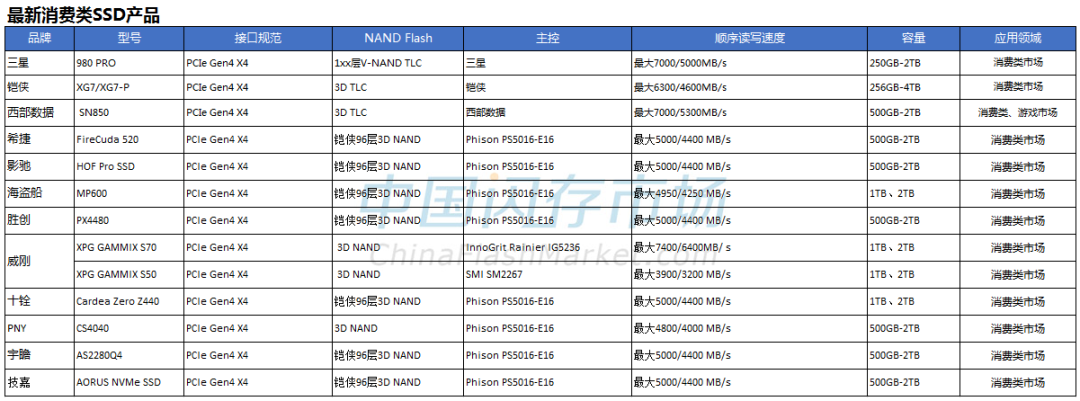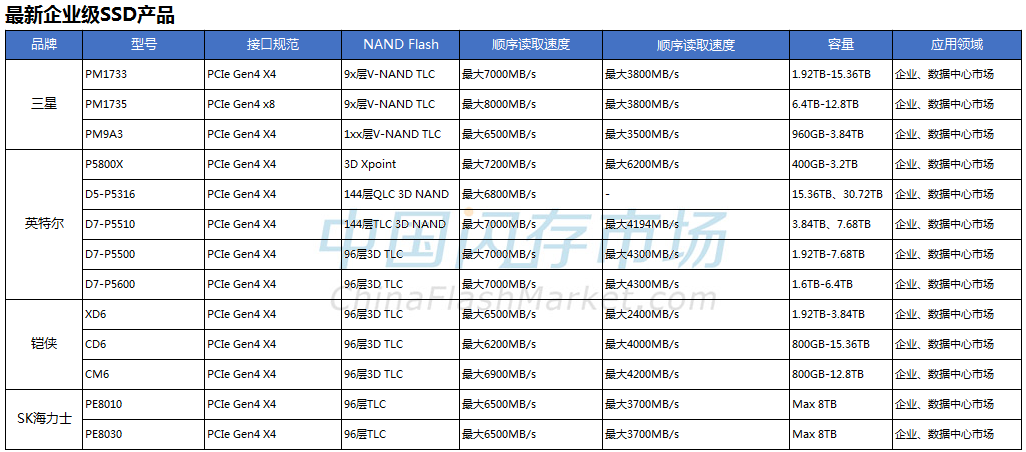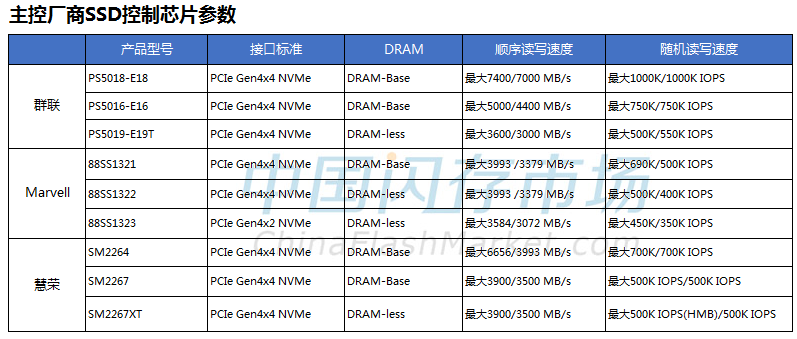
The global “pandemic” in 2020 drove the growth of the home economy, with online meetings, online videos, and online education leading to a continuous increase in laptop shipments. At the same time, the demand for storage performance and capacity in data center systems of internet companies is also on the rise.
SSDs not only meet the rapidly increasing demands for high-speed data transmission, quick response, and efficient analysis, but they also have significant development potential in the future. As a key focus for various enterprises, what trends will SSDs see in 2021?
1. The Market for 1XX-Layer 3D NAND in SSDs Will Expand in 2021
In 2020, major flash manufacturers focused on increasing the adoption of 9x-layer 3D NAND in the market. Samsung’s 1XX-layer, Western Digital/Kioxia’s 112-layer, SK Hynix’s 128-layer, Micron’s 128-layer, and Intel’s 144-layer 3D NAND have all increased their production ratios and actively promoted their application in SSD products.
Among them, Samsung launched the consumer-oriented 980 PRO series PCIe 4.0 NVMe SSD, which for the first time uses Samsung’s 1XX-layer TLC NAND flash, fully leveraging the potential of PCIe Gen4, achieving performance close to theoretical speeds. SK Hynix, based on 128-layer 4D NAND, has not only launched the Gold P31 and Platinum P31 series consumer SSDs but also released the enterprise-grade PE8111 series SSDs. Intel has also introduced consumer-grade 670p SSDs, data center D7-P5510 SSDs, and D5-P5316 SSDs based on 144-layer 3D NAND.
By the end of 2020, with Micron and SK Hynix publicly announcing their breakthroughs in 176-layer 3D NAND technology, Samsung is also expected to mass-produce its seventh-generation V-NAND in 2021, with new SSDs anticipated to debut this year.

2. Intel Leads Growth in QLC SSD Shipments, More New SSDs to Debut in 2021
As early as 2018, Intel and Micron were the first to launch the industry’s first 64-layer 3D QLC, bringing QLC SSDs into the public eye. They have since released consumer-grade 660p and 665p SSDs, as well as data center D5-P4320, D5-4420, and D5-4326 SSDs. At the beginning of 2020, Intel announced that it had produced over 10 million QLC 3D NAND SSDs at its Dalian factory since the end of 2018.
In December 2020, Intel released its latest 144-layer QLC NAND, which offers approximately a 50% increase in capacity density compared to the 96-layer QLC, fully entering the QLC era. The 144-layer QLC from Intel has a single die capacity of 1Tb, and based on this new technology, Intel has launched the U.2 specification PCIe SSD D5-P5316 for data centers, with a capacity of up to 30.72 TB, and also released new 670p series SSDs for the consumer market.
In addition to Intel, the Samsung 870 QVO series, Micron 2300/2210, and others also utilize QLC NAND. Furthermore, SSD controller manufacturers such as Marvell, SMI, and Phison have introduced SSD controller chips that fully support 3D TLC/QLC, with other SSD brands like Kingston, JMicron, and ADATA also gradually launching QLC SSDs.
NAND Flash has evolved from SLC to QLC, allowing for larger single die capacities, resulting in higher SSD capacities and lower unit prices. Additionally, PLC is currently under development, which, compared to QLC, offers a 25% increase in unit capacity, not only accelerating QLC’s mainstream adoption but also significantly reducing the cost of TB-level SSDs.
3. Original Manufacturers’ PCIe 4.0 Shine Brightly, Driving Consumer Market Applications in 2021
The global data volume continues to grow rapidly. Compared to PCIe 3.0, PCIe 4.0 doubles the maximum bandwidth, with PCIe 4.0 x4 channels providing an ultra-high theoretical bandwidth of 8GB/s, allowing SSD performance to theoretically reach 7GB/s. In 2020, original manufacturers like Samsung, Intel, Kioxia, and SK Hynix all offered TB-level PCIe 4.0 SSDs, targeting the data center storage sector.

In the consumer market, the support for PCIe 4.0 by AMD’s third-generation Ryzen 3 series processors and Intel’s 11th-generation Core processors will drive the new generation of PCIe 4.0 SSDs to expand from the server market into gaming consoles, high-end PC OEMs, and automotive markets.
In 2020, brands like Kingston, Seagate, JMicron, and Galax have launched PCIe 4.0 SSDs or have new products set to hit the market, with capacities generally at 500GB, 1TB, and 2TB, which are higher than the typical capacities of 250GB, 500GB, and 1TB seen in the PCIe 3.0 SSD era.
4. Controller Manufacturers Have Positioned PCIe 4.0 and Are Expanding into the Enterprise SSD Market
The enterprise SSD market has long been dominated by original manufacturers like Samsung, Intel, Western Digital, and SK Hynix. However, with the continuous development of the internet market, especially the popularization of 5G networks, the demand for enterprise SSDs is increasing. Manufacturers like SMI and Phison are also beginning to focus more on the enterprise market.

SMI claims that its consumer-grade PCIe 4.0 SSD controller chips fully meet market demands and have gained favor from over ten customers. In 2020, SMI also released the enterprise-grade PCIe 4.0 NVMe SSD controller chip SM8266, which will facilitate the transition of enterprise SSDs from PCIe 3.0 to PCIe 4.0.
Phison’s new generation of customizable enterprise SSD solutions, the FX series, is designed for the purpose-built storage market, featuring a new 12-channel architecture and ARM Cortex R5 architecture, adhering to the PCIe Gen3 x4 interface standard, achieving a maximum sequential read speed of 3400MB/s and random read speeds of up to 640K IOPs, providing better options for high-performance computing, artificial intelligence (AI), application servers, and large-scale data centers.
Latest Recommended Reading:
-
After breaking through 176-layer 3D NAND, Micron’s DRAM technology trends are surprising!
-
Fear of shortages spreads, channel SSDs achieve four consecutive weeks of price increases, with some DRAM products seeing weekly increases of nearly 8%
-
Significant impacts on the storage industry, major events and technological breakthroughs in 2020 are all here!
-
After selling its NAND business, where will Intel’s storage path lead?
-
Intel’s new 144-layer QLC SSDs are set to debut, with PLC, the “killer app” for TB capacity SSDs, on the way!
